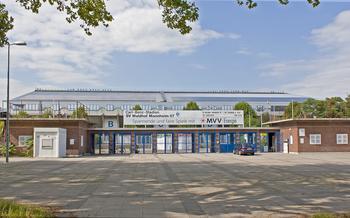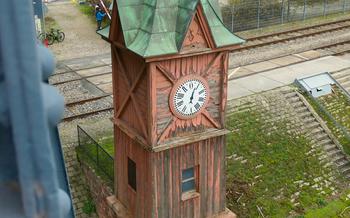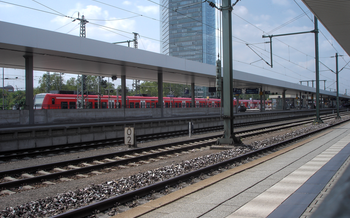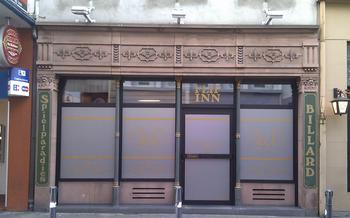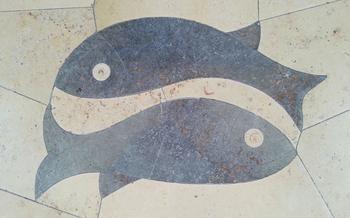
Carl Benz House
- The Carl Benz House: A Monument to Automotive History
- Exploring the Museum's Exhibits
- The Birthplace of the Automobile
- Carl Benz: The Father of the Automobile
- The Benz Patent-Motorwagen: A Revolutionary Invention
- Interactive Displays and Hands-On Activities
- Guided Tours and Workshops
- Museum Shop and Café
- Getting to the Carl Benz House
- Nearby Attractions
- Historical Context of the Automobile
- The Legacy of Carl Benz
- Educational Resources
The Carl Benz House: A Monument to Automotive History
The Carl Benz House, located in Mannheim, Germany, stands as a testament to the birth of the automobile. Built in 1871, this unassuming building was the birthplace of automotive history when Carl Benz, a German engineer and inventor, created the world's first practical automobile, the Benz Patent-Motorwagen, in 188The house is now a museum dedicated to the life and work of Benz and his revolutionary invention.
Inside the museum, visitors can explore a treasure trove of exhibits showcasing vintage cars, engines, and other artifacts from the early days of the automobile industry. Interactive displays and hands-on activities bring the history of automotive innovation to life, providing visitors of all ages with an immersive and educational experience.
Carl Benz's contributions to the automotive industry were profound. His invention of the internal combustion engine, the three-wheeled Benz Patent-Motorwagen, and the first four-wheeled automobile revolutionized transportation and laid the foundation for the modern automotive industry. Benz's pioneering spirit and engineering genius earned him the title of "Father of the Automobile."
According to a popular anecdote, Benz's early experiments with internal combustion engines were met with skepticism and amusement from his neighbors. Undeterred, Benz continued his work, and in 1879, he successfully tested his first engine, which ran on a mixture of gasoline and ligroin. This breakthrough paved the way for the development of the Benz Patent-Motorwagen, which would change the course of transportation history forever.
Exploring the Museum's Exhibits
The Carl Benz House Museum offers a captivating journey through automotive history, showcasing an impressive collection of vintage cars, engines, and interactive displays that bring the past to life. Among the highlights of the museum's collection is the original Benz Patent-Motorwagen, the world's first practical automobile, which holds a prominent place of honor. Visitors can marvel at this revolutionary invention and learn about its groundbreaking impact on transportation and society.
Interactive displays and hands-on activities make the museum an engaging and immersive experience for visitors of all ages. Visitors can step into the shoes of Carl Benz himself and simulate driving the Patent-Motorwagen on a virtual reality race track, experiencing the thrill and challenges of early motoring. They can also explore interactive exhibits that demonstrate the engineering principles behind Benz's inventions, such as the four-stroke engine and the carburetor.
The museum provides a fascinating glimpse into the life and work of Carl Benz and his contemporaries. Visitors can learn about Benz's early experiments with internal combustion engines, his collaboration with Gottlieb Daimler, and his relentless pursuit of innovation. Personal stories and anecdotes bring these historical figures to life and reveal the passion and determination that fueled their groundbreaking work.
The Birthplace of the Automobile
Mannheim, Germany, holds a pivotal place in automotive history as the birthplace of the automobile. During the late 19th century, the city was a thriving center of innovation and industry, attracting ambitious minds from around the world. One such individual was Carl Benz, a visionary engineer who would revolutionize transportation forever.
Benz's pioneering work in engine development and vehicle design culminated in the creation of the Benz Patent-Motorwagen, the world's first practical automobile. Unveiled in 1885, this groundbreaking invention marked a pivotal moment in human history, ushering in a new era of mobility and freedom.
The Carl Benz House, located in Mannheim, stands as a testament to the city's contributions to automotive history. This historic building was once the home and workshop of Carl Benz, where he toiled tirelessly to bring his automotive dreams to life. Today, the Carl Benz House has been transformed into a museum, preserving the legacy of this remarkable inventor and showcasing the evolution of the automobile.
Visitors to the museum can immerse themselves in the fascinating story of Carl Benz and his groundbreaking invention. Through interactive exhibits, hands-on activities, and guided tours, the museum brings to life the ingenuity and perseverance that led to the creation of the automobile.
One anecdote that vividly illustrates the significance of Mannheim as the birthplace of the automobile is the story of the first public demonstration of the Benz Patent-Motorwagen. On July 3, 1886, Benz boldly took his invention for a spin on the streets of Mannheim, captivating onlookers with its unprecedented speed and maneuverability. This historic event marked the beginning of a new era in transportation, and Mannheim forever etched its name in the annals of automotive history.
Carl Benz: The Father of the Automobile
Carl Benz, born on November 25, 1844, in Karlsruhe, Germany, is widely regarded as the father of the automobile. His pioneering work in engine development and vehicle design revolutionized transportation and laid the foundation for the modern automotive industry.
Benz's early life was marked by a keen interest in engineering and mechanics. He studied mechanical engineering at the Polytechnic Institute in Karlsruhe and later worked as a draftsman and engineer in various companies. In 1871, he founded his own company, Benz & Cie., which initially focused on the production of two-stroke engines.
Benz's relentless pursuit of innovation led him to develop the first practical internal combustion engine in 187This breakthrough paved the way for the creation of the world's first automobile, the Benz Patent-Motorwagen, in 188The three-wheeled vehicle featured a rear-mounted engine, a carburetor, and a rudimentary transmission system.
Benz's invention sparked a revolution in transportation. He tirelessly promoted his automobile, demonstrating its capabilities through public demonstrations and long-distance journeys. His perseverance and dedication earned him widespread recognition, and he became one of the most important figures in automotive history.
Anecdote:
In 1886, Benz embarked on a daring journey to prove the reliability and endurance of his Patent-Motorwagen. Accompanied by his wife, Bertha Benz, and their two sons, he drove the vehicle over 100 miles from Mannheim to Pforzheim, Germany. This remarkable trip, undertaken without maps or proper roads, demonstrated the practicality and potential of the automobile.
The Benz Patent-Motorwagen: A Revolutionary Invention
The Benz Patent-Motorwagen, unveiled to the world in 1885, marked a pivotal moment in automotive history. This three-wheeled vehicle, powered by a four-stroke gasoline engine, was the brainchild of Carl Benz, a visionary engineer and inventor. With its lightweight tubular frame, wooden wheels, and tiller steering, the Patent-Motorwagen embodied a radical departure from traditional horse-drawn carriages.
Benz's invention was not merely a technological marvel but a testament to his unwavering persistence. Despite skepticism and setbacks, he relentlessly pursued his dream of a self-propelled vehicle. The Patent-Motorwagen's innovative features, including its single-cylinder engine, carburetor, and radiator, laid the foundation for the modern automobile.
The impact of the Benz Patent-Motorwagen was profound. It ushered in an era of mechanized transportation, transforming the way people traveled and transported goods. Benz's invention revolutionized industries, spurred economic growth, and paved the way for the automotive industry as we know it today.
Anecdote:
In 1888, Bertha Benz, Carl Benz's wife, embarked on a daring adventure with the Patent-Motorwagen. Without her husband's knowledge, she took their two sons on a 106-mile journey from Mannheim to Pforzheim, Germany. This audacious trip, undertaken to prove the vehicle's practicality, garnered widespread attention and helped to dispel skepticism surrounding the automobile's potential.
Interactive Displays and Hands-On Activities
The Carl Benz Museum offers a variety of interactive displays and hands-on activities that engage visitors of all ages and enhance their understanding of automotive history. These displays bring the museum's exhibits to life and allow visitors to experience the history of the automobile in a fun and interactive way.
One of the highlights of the museum is the driving simulator, which allows visitors to experience the thrill of driving one of Carl Benz's early automobiles. Visitors can choose from a variety of virtual courses, including a city street, a country road, and a race track. The simulator provides a realistic and immersive driving experience, allowing visitors to feel what it was like to drive one of these early vehicles.
Another popular interactive exhibit is the virtual reality experience, which takes visitors on a journey through the history of the automobile. Visitors can explore the streets of Mannheim in the late 19th century, visit the Carl Benz factory, and even ride in one of Benz's early automobiles. The virtual reality experience is a great way to learn about the history of the automobile and experience it from a first-person perspective.
In addition to the driving simulator and virtual reality experience, the museum also offers a variety of other interactive displays and hands-on activities. Visitors can explore the inner workings of an engine, build their own model car, and even design their own car. These activities are a great way for visitors to learn about the engineering and design principles behind the automobile.
The interactive displays and hands-on activities at the Carl Benz Museum make it a fun and educational experience for visitors of all ages. These displays bring the museum's exhibits to life and allow visitors to experience the history of the automobile in a unique and engaging way.
Anecdote:
A young boy named Max was visiting the Carl Benz Museum with his family. He was particularly excited to try out the driving simulator. He climbed into the driver's seat and selected the city street course. As the simulation began, Max felt the thrill of driving one of Carl Benz's early automobiles. He navigated the streets of Mannheim, avoiding pedestrians and other vehicles. He even got to experience what it was like to drive over cobblestones. Max had so much fun that he didn't want to stop driving. He spent the rest of the day exploring the museum's other interactive exhibits and learning about the history of the automobile.
Guided Tours and Workshops
The Carl Benz House offers guided tours of the museum, led by knowledgeable docents who provide insights into the history of the automobile and the life of Carl Benz. These tours are available in several languages and can be booked in advance or on-site. The museum also offers educational programs and workshops for students and adults, focusing on various aspects of automotive history and technology. These programs and workshops provide hands-on learning experiences and allow participants to explore the museum's collection in greater depth.
One of the highlights of the guided tours is the opportunity to see some of the museum's rarest and most valuable exhibits, such as the original Benz Patent-Motorwagen. The docents share fascinating stories about the development and impact of these vehicles, as well as the challenges and triumphs faced by Carl Benz and his contemporaries.
For those interested in delving deeper into the world of automotive history, the museum also offers workshops on various topics, such as engine repair, vehicle restoration, and automotive design. These workshops are led by experienced professionals and provide participants with the opportunity to learn from experts in the field.
Anecdote:
During a recent guided tour, a group of visitors was particularly intrigued by a rare and beautifully preserved Mercedes-Benz 300 SL Gullwing. The docent explained that this iconic sports car was one of the most sought-after vehicles of its time and was known for its distinctive gull-wing doors. The visitors were fascinated by the car's history and design, and many of them took the opportunity to take photos and ask questions about its specifications.
Museum Shop and Café
The Carl Benz House offers a well-stocked museum shop where visitors can purchase a variety of souvenirs and automotive-themed merchandise to commemorate their visit. From scale models of vintage cars to books on automotive history, the shop offers something for every enthusiast. Visitors can also find a selection of clothing, accessories, and gifts inspired by the world of automobiles.
The museum also features a cozy café where visitors can take a break and enjoy refreshments or a light meal. The café offers a range of beverages, including coffee, tea, and soft drinks, as well as a selection of sandwiches, salads, and pastries. Visitors can relax and refuel while enjoying the museum's ambiance and reflecting on the history of the automobile.
The convenience of these amenities makes the Carl Benz House a welcoming and enjoyable destination for visitors of all ages. Whether you are looking for a unique souvenir to remember your visit or a place to relax and refuel, the museum shop and café have something to offer.
Anecdote:
A visitor named Sarah was browsing the museum shop when she spotted a miniature replica of the Benz Patent-Motorwagen. She had always been fascinated by the history of the automobile, and she knew that this was the perfect souvenir to commemorate her visit to the Carl Benz House. Sarah purchased the replica and placed it on her desk at work, where it served as a daily reminder of her trip to Mannheim and the birthplace of the automobile.
Getting to the Carl Benz House
The Carl Benz House is conveniently located in the heart of Mannheim, making it easily accessible by various means of transportation. For those arriving by car, the museum offers ample parking options in the vicinity. Simply follow the signs to the museum, and you'll find designated parking spaces reserved for visitors.
If you prefer public transportation, the museum is well-connected by tram and bus lines. Several stops are located within walking distance of the museum, making it easy to reach from anywhere in the city. Just check the local transportation schedules to plan your journey accordingly.
For those who enjoy walking or cycling, the Carl Benz House is a pleasant destination to explore on foot or on two wheels. The museum is situated in a pedestrian-friendly area, with dedicated bike lanes and sidewalks. Take a leisurely stroll or a scenic bike ride along the picturesque streets of Mannheim, and you'll find yourself at the doorstep of the museum in no time.
Once you arrive at the museum, you'll be greeted by a welcoming entrance that leads you into the fascinating world of automotive history. So, whether you're a car enthusiast, a history buff, or simply curious about the origins of the automobile, the Carl Benz House is waiting to take you on an unforgettable journey.
Anecdote:
A group of friends decided to visit the Carl Benz House on a sunny afternoon. They arrived by car and easily found a parking spot just a short walk from the museum. As they strolled towards the entrance, they couldn't help but admire the historic buildings and charming streets that lined their path. The excitement grew as they approached the museum, eager to discover the stories behind the birth of the automobile.
Nearby Attractions
Beyond the Carl Benz House, Mannheim offers a diverse array of attractions for visitors to explore. The city's rich history and cultural heritage are reflected in its many museums, including the Mannheim Palace, which houses an impressive collection of art and artifacts. For those seeking a tranquil oasis, the Luisenpark, with its sprawling gardens, exotic animals, and serene lake, provides a welcome respite from the urban hustle and bustle. Art enthusiasts will delight in the Kunsthalle Mannheim, renowned for its extensive collection of modern and contemporary art.
A visit to Mannheim can be easily combined with a broader exploration of the surrounding region. Heidelberg, with its picturesque old town and iconic castle, is just a short train ride away. The Rhine Valley, with its rolling vineyards, charming villages, and majestic castles, offers a scenic backdrop for a leisurely drive or bike ride. Whether you seek cultural immersion, outdoor adventures, or historical exploration, Mannheim and its surroundings promise an enriching and memorable experience.
One visitor, drawn to Mannheim by the allure of the Carl Benz House, discovered the city's hidden gem quite by accident. While strolling along the banks of the Rhine, they stumbled upon a charming café nestled amidst the lush greenery of a riverside park. Intrigued by the aroma of freshly baked pastries, they decided to stop for a coffee and a bite to eat. As they sat savoring their treats, they overheard a group of locals discussing the history of the city and its role in the development of the automobile. Inspired by their conversation, the visitor resolved to explore Mannheim's automotive heritage further, leading to an unexpected and delightful addition to their trip.
Historical Context of the Automobile
The development of the automobile was a pivotal moment in human history, revolutionizing transportation and society. Several factors converged to make this invention possible. The Industrial Revolution brought about advancements in manufacturing and engineering, providing the necessary tools and materials to build automobiles. The rise of the middle class created a demand for personal transportation, as people sought greater mobility and independence. Additionally, the discovery of petroleum and its refining into gasoline provided a reliable fuel source for internal combustion engines.
Germany played a significant role in the early history of the automobile. The country had a strong industrial base and a tradition of engineering excellence. German inventors and engineers, such as Carl Benz, Gottlieb Daimler, and Wilhelm Maybach, were at the forefront of automotive innovation. They developed and refined the internal combustion engine, creating practical and reliable vehicles. These early automobiles paved the way for the mass production and widespread adoption of cars, transforming transportation and shaping modern society.
Anecdote:
As I stood in the Carl Benz House, surrounded by the exhibits showcasing the early days of the automobile, I couldn't help but marvel at the profound impact this invention has had on our world. From humble beginnings in workshops and garages, the automobile has evolved into an integral part of our lives, connecting communities, facilitating travel, and driving economic growth. It's fascinating to think that the seeds of this transportation revolution were sown right here in Mannheim, where Carl Benz's vision and ingenuity gave birth to the automobile.
The Legacy of Carl Benz
Carl Benz's legacy extends far beyond his pioneering work with the internal combustion engine. He was a visionary entrepreneur who laid the foundation for the modern automotive industry. His relentless pursuit of innovation and his commitment to quality and precision engineering set the standard for automobile manufacturing. Benz's contributions to the field of transportation have had a profound impact on society, transforming the way people travel, work, and live.
Benz's legacy is evident in the success of the Mercedes-Benz brand, which he co-founded with Gottlieb Daimler. Mercedes-Benz has become synonymous with luxury, performance, and reliability, and its vehicles are recognized around the world as symbols of automotive excellence. Benz's pioneering spirit and his unwavering belief in the potential of the automobile continue to inspire generations of engineers and designers.
To this day, Benz's legacy is celebrated in Mannheim, the city where he lived and worked. The Carl Benz House, now a museum dedicated to his life and achievements, attracts visitors from around the world who come to learn about the birth of the automobile and the man who made it possible. Benz's legacy is a testament to the power of innovation and the enduring impact of one man's vision.
Anecdote:
During a visit to the Carl Benz House, a young engineer was captivated by the story of Benz's early experiments. Inspired by Benz's ingenuity and determination, the engineer went on to pursue a career in automotive engineering. He eventually became a leading expert in the field, developing new technologies that improved the safety and efficiency of vehicles. In his own way, the engineer carried on Benz's legacy of innovation and excellence, ensuring that Benz's contributions to the automotive industry would continue to benefit society for generations to come.
Educational Resources
The Carl Benz House also serves as a valuable educational resource for students and teachers alike. The museum offers a range of educational programs and resources designed to enhance classroom learning and inspire students to pursue careers in STEM fields. These programs include guided tours tailored to different grade levels, interactive workshops on automotive history and engineering, and hands-on activities that bring the exhibits to life.
Additionally, the museum's website features a wealth of online resources, including virtual exhibits, educational materials, and lesson plans that can be easily integrated into the classroom curriculum. Teachers can access these resources to supplement their lessons, provide students with interactive learning experiences, and foster a deeper understanding of automotive history and technology.
One inspiring anecdote illustrates the impact of the museum's educational resources. A teacher named Ms. Johnson brought her fifth-grade class to the Carl Benz House for a guided tour. The students were captivated by the interactive exhibits and the knowledgeable docent who explained the history of the automobile in a way that made it both engaging and understandable.
After the tour, Ms. Johnson used the museum's educational resources to create a unit on transportation for her class. She incorporated virtual exhibits, hands-on activities, and lesson plans from the museum's website into her lessons. The students were excited to learn about the history of the automobile and were inspired to design their own model cars using recycled materials.
Ms. Johnson's experience highlights the value of the Carl Benz House as an educational resource. The museum's programs and resources provide students with a unique opportunity to learn about automotive history, engineering, and innovation in a fun and interactive way, sparking their curiosity and inspiring them to pursue further exploration in STEM fields.
